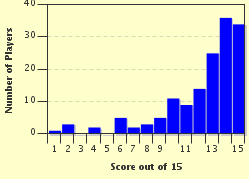Quiz Answer Key and Fun Facts
1. The very first historical character to appear on a British banknote appeared on the £20 note issued in July 1970. This person is perhaps the world's most famous playwright. Who is he?
2. In 1971, a £5 note was issued depicting this famous British soldier who commanded troops from Britain, Germany, Belgium, Holland and Prussia against the French under the command of Napoleon in 1815. Can you name him?
3. The first female figure from history to make an appearance on a British banknote came from the battlefields of Crimea in the 1850s. She appeared on the £10 note issued in February 1975. Who was she?
4. In February 1978, the first (and last) £1 banknote to have a historical character printed on it was issued. The note has a sense of gravity about it which is not present on other British banknotes. Which individual was this?
5. In March 1981, this architect appeared on a £50 note. He appears on the back of the note with a view of his most famous building and also a floor plan. Can you name him?
6. In June 1990, a new £5 note was issued with a famous engineer and railway pioneer on the reverse. What is his name?
7. It was the turn of the £20 note to be reworked in June 1991. A famous Victorian scientist appeared on this note. Each year, a series of lectures in his name are put on by the Royal Institution which are widely broadcast throughout the world. Who is he?
8. In April 1992, another writer was honoured by appearing on the £10 note. This person died in 1870 aged 58. He/she left a legacy of stories which are still immediately associated with his/her name throughout the English speaking world. Can you name him/her?
9. A new £50 note was issued in 1994. The character included on the note was the first Governor of the Bank of England (1694-97). The note features his portrait and his house in Threadneedle Street, which was built on the current site of the Bank of England. Who was he?
10. In 1999 a £20 note featuring one of England's greatest composers was issued. His most famous compositions are probably the "Enigma Variations" and the "Pomp and Circumstance" Marches. What is his name?
11. The character found on the £10 note issued in November 2000 is famous the world over. He was born in Shrewsbury, the county town of Shropshire in 1809. He made his name by taking part in a five year voyage around the world studying the flora and fauna he found in different countries and propounding a famous theory on his return to the UK.
12. The second woman to appear on a British banknote (other than the Queen) made her appearance on the £5 note in 2002. This lady was a leading light in the campaign to introduce legislation to improve the treatment of prisoners. Who was she?
13. In 2007, a new £20 banknote was issued with a Scottish philosopher portrayed on it. He was the author of a book called "An Inquiry into the Nature and Causes of the Wealth of Nations", written in 1776. Who was he?
14. In 2011, a £50 note was issued with a historic partnership depicted on it. One was an English manufacturer of metal products. His more famous partner was a Scottish engineer who made rapid strides in improving the design of the Newcomen Steam Engine,the first practical steam engine in the world. The two together were a major influence on the industrial revolution. Who were they?
15. It was announced in December 2013 that a new £5 banknote featuring Winston Churchill would be issued in 2016 and a new £10 banknote issued featuring the writer Jane Austen about 12 months later. The Churchill note was intended to be different to any other banknote previously issued by the Bank of England. In what way?
Source: Author
Spontini
This quiz was reviewed by FunTrivia editor
stedman before going online.
Any errors found in FunTrivia content are routinely corrected through our feedback system.

